Learning Objectives
- Describe the differences among functional, chronological, combination, and scannable résumés.
- Identify when the above résumé formats are appropriate.
- Prepare a résumé in the proper format based on your qualifications and desired job.
A résumé is the standard document for listing experience and qualifications for potential employers. The résumé serves three distinct purposes that define its format, design, and presentation:
- To represent your polished, professional qualifications in writing
- To demonstrate how your unique experience and skill set meet the needs of an employer
- To obtain an interview through your thoughtfully prepared, customized, and detailed work
A résumé is your best professional representation of yourself on paper. Often, this document is the primary thing a potential employer sees. Therefore, your résumé is sometimes your only chance to make a good first impression. Every résumé you submit should be unique and customized for your desired position.
Research: Doing Your Homework
The most important step to writing a quality résumé is doing some preliminary research and planning. Your résumé should be used as a marketing tool, selling yourself to each specific company. In order to create a résumé designed to fit your exact position you wish to fill, research is necessary. Not only will possessing company knowledge help you write a perfect résumé, but also when writing your cover letter and during the interview process. With this in mind, you will utilize these same research tips and techniques in section 9.2.
There are three components to company research:
- Learning the company’s culture and values
- Familiarizing yourself with important data, achievements, and goals
- Identifying the names of company contacts (we will address this further in section 9.2 on cover letters)
Company Culture & Values
An innovative way to make your résumé shine is to incorporate aspects of the company culture and values. Start by researching the company’s mission statement and core values. Usually, this can be found on the organization’s website, facebook page, or LinkedIn. An example of a large company with a clearly defined mission statement and values is Starbucks Coffee. Visit their website https://www.starbucks.com/about-us/company-information and you will find a plethora of information. See the below figures for their mission statement and core values.
Starbucks Mission Statement
To inspire and nurture the human spirit – one person, one cup and one neighborhood at a time.
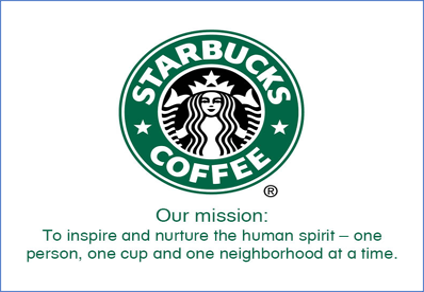
Starbucks Core Values
- Provide a great work environment and treat each other with respect and dignity.
- Embrace diversity as an essential component in the way we do business.
- Apply the highest standards of excellence to the purchasing, roasting, and fresh delivery of our coffee.
- Develop enthusiastically satisfied customers all the time.
- Contribute positively to our communities and our environment.
- Recognize that profitability is essential to our future success.
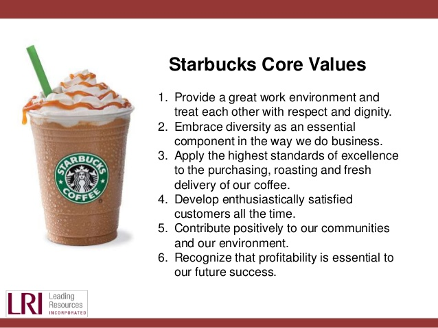
Starbucks’ website mentions the word ethics a total of 10 times on their business compliance and ethics section. They also boast a 10-year membership on the World’s Most Ethical Company list (Starbucks Corporation, 2017). From the information provided, you can get a sense of the skills and accomplishments you would want to include on your résumé if you were applying to the Starbucks Corporation.
An ideal résumé for Starbucks may include:
- An emphasis on ethics and values – Incorporate these keywords in your skills section, work history, or any other appropriate subcategory
- A global perspective – a focus on diversity and respect for others. Starbucks actively seeks out ways to make the world a better place and advocates for fair treatment for all. With this is mind, it may be beneficial to include hobbies and interests that represent these values. For example, if you are a member of a multicultural club or volunteer to teach English in your community, you could include this in your hobbies and interests section.
- Customer service – hone in on your people skills. According to their mission statement, Starbucks values individuals and their neighborhoods. If you have experience directly serving people, it may be a good idea to elaborate on this in your work history section.
Gathering Data
Another tip you may want to use when researching for your résumé and cover letter is to gather data. Specific numbers can be obtained through government and .org websites and are often published on the company websites as well. Familiarizing yourself with numerical data can give you an idea of what the company is looking for in a successful employee. Let’s revisit Starbucks Coffee for another example of how company research can boost your résumé.
If you are applying for an opening in Starbucks corporate, there are many facts that may be helpful to know. Starbucks has a separate page on their website specifically to gain this information. Viewing their company profile, you can see that they have “more than 25,000 companies in 75 countries” (Starbucks Corporation, 2017). Now you have an idea of the scope of the large coffee chain you are interested in. Perhaps you have experience working for another large corporation with similar figures. Your work history may include:
Senior Financial Specialist, Large Corporation, Inc, Chicago, Illinois
- Handled accounts for 50 of 20,000 stores
- Managed investments in 12 different countries
- Etc.
Remember, specific numbers and data will also be important to use in your cover letters as a way to attract immediate attention.
Contacts
When creating an employment document, always be sure to address it to the appropriate individual. This will be addressed further in section 9.2.
Types of Résumés & When to Use Them
There is no “one-size-fits-all” when it comes to formatting your résumé. You may find yourself using different styles depending on the situation. The appropriate format should correlate to your amount of related work experience, education, and expertise.
Functional
A résumé that is skills-focused rather than employment history is called a functional résumé. For recent college graduates with little or no field experience, this style is ideal. Someone with gaps in their work history or those who change jobs frequently also benefit from a functional format (Job Search and Resumes in the Digital Age, 554). The document begins with several accomplishments and skills grouped together, ending with information on work experience, which is not as detailed.
While a functional résumé is the right choice for some, it is not for everyone. An expert in their field with an impressive work history would not benefit from deemphasizing their experience. Additionally, some employers and recruiters may require the more traditional chronological format. Discretion should be used when utilizing the functional style of résumé. Emphasizing skills over work experience could alert suspicion amongst recruiters.

Chronological
A chronological résumé lists work history in order, beginning with the most recent. This style is by far the most popular and widely preferred by recruiters. An organized concentration on work experience and education is what makes the chronological style good for quick skimming and navigating. Chronological résumés best serve applicants with extensive experience and those who demonstrate steady career growth (Job Search and Resumes in the Digital Age, 554). On the other hand, an applicant with obvious gaps in their career, frequent job changes, or recent college graduates may not want to use a chronological format.

Combination
Combination résumés start in a functional format and end chronologically, or vica versa. Perhaps the best of both functional and chronological worlds, a combination format leaves room for plenty of detail. Executive-level applicants and field masters thrive with this type of résumé.
If your education is your highest qualification for the job, do not use the combination style.
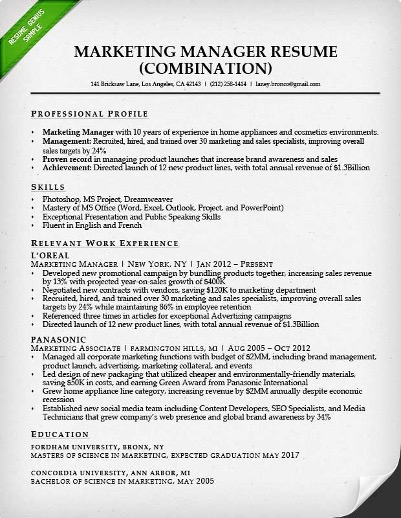
Scanable
Scannable Résumés can be read by a computer or Applicant Tracking System (ATS). LinkedIn suggests that 90 percent of large companies use ATS (Squibb, 1). Therefore, it is increasingly necessary to learn how to prepare a scannable résumé. Although scannable résumés are incredibly popular, you must still have a traditional résumé on hand.
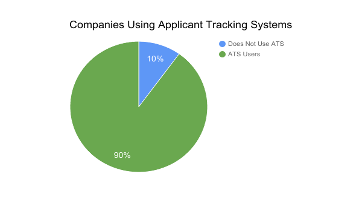
You need to make sure your résumé is easy to read by a computer, including a character recognition program. That means no italics, underlining, shading, boxes, or lines. Choose a sans serif (without serif, or decorative end) font like Arial or Tahoma that won’t be misread. Simple, clear fonts that demonstrate no points at which letters may appear to overlap will increase the probability of the computer getting it right the first time. In order for the computer to do this, you have to consider your audience—a computer program that will not be able to interpret your unusual font or odd word choice. A font size of eleven or twelve is easier to read for most people, and while the computer doesn’t care about font size, the smaller your font, the more likely the computer is to make the error of combining adjacent letters.
The length of a scannable document is not significant – a computer does not register length Résumés should be freshly printed, kept neat and straight, and in black and white – optimal for scanning. (Roever, 156). ATS picks up on keywords the employer is looking for. This is yet another instance where pre-writing research will be crucial. Do your research and incorporate keywords employers want. Read the company website, mission statement, job posting, etc. to get an idea of words that will stand out.
Résumé Length
You may have had it drilled into your head that your résumé must fit on a single typed page. Although this used to be the common standard, evidence suggests that it may have evolved. Statistically, recruiters rank two-page resumes higher than single-page ones. The favoritism of two-pagers is a result of the pertinent and persuasive information that comes with additional length (Blackburn-Brockman & Belanger, 36). With a second page there is an opportunity to get creative. For example, second pages provide space for impressive skills and experiences such as volunteering, hobbies and interests, leadership roles, and accomplishments. A resume containing more than work experience portrays an applicant as well-rounded and likeable.
A survey conducted by AccounTemps found executives had strong, yet varying résumé length preferences depending on who was applying for the job. For executive-level applicants, the survey found an overwhelming majority (62%) preferred a two-page résumé. Several respondents (32%) indicated that 3 pages is appropriate for highly experienced job seekers (HR Focus, 1).

However, when it came to staff-level applicants, the responses were a little more divided. 52% deemed a one page application best, while 44 percent preferred a two-paged one (HR Focus, 1).
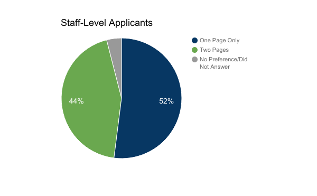
Like formats, deciding on a length for your résumé is a matter of personal discretion. Your résumé should be as long as it needs to be in order to effectively present your skills (Guffey & Loewy, 554).
Style, Layout, & Design
There are two components to résumé effectiveness: format and content (Beatty, 5). For the former, there are some important housekeeping details to keep in mind when writing the perfect résumé. These rules might seem arbitrary, but they will keep your résumé looking polished and ready for review:
- Use white space tastefully (Schaub, 2017)
- Keep your number of headings to a maximum of 6 (Guffey & Loewy, 556)
- Use parallelism (i.e. corresponding grammatical structure) (Schaub, 2017)
- Utilize columns (Schaub, 2017)
- Font should reflect tone and personality (Schaub, 2017)
- Use phrases – not sentences (Schaub, 2017)
- Avoid first-person (Schaub, 2017)
- Be concise (Schaub, 2017)
- Words should be more dynamic than nouns (Schaub, 2017)
Content: What is Important?
You may have gathered at this point in the chapter that using personal discretion is needed for writing employment documents. It is helpful to ask yourself what is important to include on your résumé and what is not. Think about the information that is relevant to the specific job you’re applying for, then consider the logical order it should go in. Grand Valley State University Business Communications professor, Mark Schaub, reminds his students that details make an applicant credible. Using specific details is evidence of experience (Schaub, 2017). Be sure to list your best qualifications first and use clear, uncluttered headings.
Summary or Objective Statement:
Many résumés begin with an opening blurb containing a career objective or summary of intent. However, objectives can be redundant if you are already attaching a cover letter. A cover letter should explain your intent and career goals, deeming an objective statement unnecessary.
Furthermore, an objective is all about you and what you want out of your career. Employment documents should always focus on what you can bring to the table and how you can benefit the employer. If you’re tempted to give more information about yourself, consider adding a skills section.
Education
Higher education is something you should be proud of, however it should not always be the main focus. If you’re experiences demonstrate your qualifications well, emphasize those over educational achievements. A special element of education on a résumé is the opportunity to add more detail and qualifications. Use details of relevant coursework and special honors to your advantage. A good education section might look like this:
Education
August 2011 – April 2015
Arizona State University, Phoenix –
Bachelor of Arts: Management
Minor: Philosophy
Deans List – Fall 2011, Winter 2011, Fall 2013, Winter 2013, Summer 2014
Management: Sought management courses to effectively communicate, organize, and team build
Leadership: Learned through studying great leaders such as Martin Luther King, Malala Yousafzai, and Jane Addams. Gained field experience through working with Phoenix community schools and organizations
Ethics: Business and personal ethics were developed through ethics and philosophy centered courses. At the center of management is an ethical core.
Although details are good when it comes to relevant coursework, some details are better left out. Be careful when determining whether or not to list your GPA. This can lead to unwanted bias. Once you have graduated college, do not include your high school on your résumé. This looks unprofessional.
Contact Information
Contact information will appear at the top of your résumé. The first element of the contact information is your name. You should use your full, legal name even if you go by your middle name or use a nickname. There will plenty of time later to clarify what you prefer to be called, but all your application documents, including those that relate to payroll, your social security number, drug screenings, background checks, fingerprint records, transcripts, certificates or degrees, should feature your legal name.
For business purposes, do not use an unprofessional e-mail address like hotrachel92@hotmale.com or 2kewl4skewl@yafoo.com. Create a new e-mail account if needed with an address suitable for professional use. The standard is typically a gmail, outlook, or university electronic mail service. Other providers can look outdated.
Tastefully include LinkedIn or online portfolio information in an aesthetically pleasing manner.
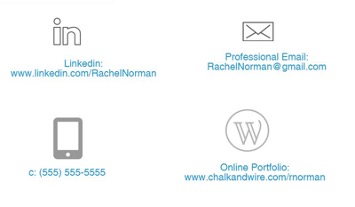
Work Experience
List in reverse chronological order your employment history, including the positions, companies, locations, dates, duties and skills demonstrated or acquired. You may choose to use active, descriptive sentences or bullet lists, but be consistent. Emphasize responsibilities that involved budgets, teamwork, supervision, and customer service when applying for positions in business and industry, but don’t let emphasis become exaggeration. This document represents you in your absence, and if information is false, at a minimum you could lose your job. Make certain to follow the format below. Refer to figure 9.20 for an example.
Follow the following format when listing work experience:
- Employer’s name, city, and state
- Dates of employment (mm/yyyy)
- Highest position attained at employer
- Roles, achievements, awards, and promotions
Your work experience will stand out if you use specific data and information. Some examples of specifics you might include are:
- Raised $10,000 for company in Fall, 2012
- Successfully eliminated paper waste
- Started community service project initiative _______.
- Handled budget of $500,000
- Supervised 10 clerical staff members
Figure 9.20 Sample Work Experience
WORK EXPERIENCE
Dolle Company, Yuma, AZ, August 2005-May 2009
Shift Manager, Lettuce Processing and Packaging
- Supervise 30 team members
- Develop, coordinate, implement, and evaluate shift schedule
- Address quality-control improvements, including employee training
Saveway Grocery, Yuma AZ, August 2004-August 2005
Assistant Produce Manager, Vegetables
- Stock, order, and manage display of vegetables in produce department
- Supervise part-time staff as needed
- Manage produce budget, including purchase orders
Hobbies & Interests

Adding a hobbies section to your résumé might affect your chances of getting interviewed more than you would think. Activities other than work add an element of humanity to your résumé and displays extra effort and thought. This section also provides a way to show qualifications, even if your related work experience is lacking. Hobbies and interests should not be a way, however, to add “fluff” (Schaub, 2017). All hobbies and interests should be carefully selected for your résumé and add depth.
Natalie Severt is a content creator for Up to Work, a company known for its résumé-builder and savvy résumé blogging and articles. Severt put together a comprehensive list of tips for a hobbies section. She starts off with the memo to always remember to put your hobbies and interests section at the bottom of your résumé, since it is not mandatory (Severt, 1).
Refer back to our section on résumé research. This will also come in handy when selecting your hobbies and interests. Severt adds that you can get an idea of what traits an employer is looking for by their job postings and websites. Keep these traits in mind when thinking about your hobbies. Extroversion and an outgoing attitude should be portrayed rather than introverted activities. Therefore, Natalie suggests leaving out solitary, reclusive activities like knitting or hanging out with your cat. (Severt, 1).
Some good hobbies to list include are:
- Sports – demonstrating you are a committed team player. When choosing individual sports, focus on describing your dedication in order to deemphasize not being a part of a team
- Puzzles, Games, Reading, Writing – these sorts of hobbies show your problem-solving side. For jobs that seek analytical, intelligent applicants, these hobbies may be helpful
- Community Engagement – volunteering or participating in the community shows ethics and a positive attitude. They are further evidence of commitment and teamwork.
Finally, consider uses phrases rather than listing your hobbies. This will leave room to add details and specifics, making your interests seem unique and tailored to your job (Severt, 1).
When in Doubt, Leave it Out
While personal characteristics and protected classes are a part of who you are, it is not recommended to include them on employment documents. Putting age, weight, height, religion, race, and sexual orientation on a résumé is not encouraged in Western society (Schaub, 2017). While there are exceptions to this rule (applying for a clergy or religious institution position, modeling jobs, or certain cultural organizations), generally, it is best to leave it out when in doubt. Including this information could lead to conscious and unconscious bias or employment discrimination.
Key Takeaway
Résumés come in many different formats, lengths, and styles. However, it is up to you to determine how to craft your résumé – a.k.a your very own personal marketing tool. Create tailored résumés for each specific position you apply for. Use discretion, proofread, do your research on the company, and present your best self.
Exercises
- Find two different jobs you would like to apply for. Research each company and customize your résumé for both. Compare with a classmate the different choices you made for each résumé and why.
- Prepare a résumé in both a chronological and functional format. Ask three peers which format they prefer and why.
References
Leading Resources, Inc, . (2014, April 24). [Image]. Examples of Company Core Values. In SlideShare. Retrieved March 19, 2017.
(2012). [Image]. Rulan’s Writing Studio. Retrieved March 17, 2017, from https://rulanq.wordpress.com/2012/11/10/95/
Starbucks Corporation, . (2017). Our Company: Our Starbucks Mission Statement. In Starbucks. Retrieved March 21, 2017, from https://www.starbucks.com/about-us/company-information/mission-statement
Starbucks Corporation, . (2017). Business Ethics and Compliance. In Starbucks. Retrieved March 21, 2017, from https://www.starbucks.com/about-us/company-information/business-ethics-and-compliance
Starbucks Corporation, . (2017). Starbucks Company Profile. In Starbucks. Retrieved March 21, 2017, from https://www.starbucks.com/about-us/company-information/starbucks-company-profile
Schaub, M. (2017) SWS Business Communication, Grand Valley State University. PowerPoint Slides. Resumes.
Blackburn-Brockman, E., & Belanger, K. (2001, January). One Page or Two?: A National Study of CPA Recruiters’ Preferences for Resume Length. The Journal of Business Communication, 38(1), 29. Retrieved from http://go.galegroup.com.ezproxy.gvsu.edu/ps/i.do?p=AONE&sw=w&u=lom_gvalleysu&v=2.1&it=r&id=GALE%7CA71327300&sid=summon&asid=e40bf01565e85404bc60da9dcc04e53a
Roever, C. (1997, March). Preparing a scannable resume. Business Communication Quarterly, 60(1), 156+. Retrieved from http://go.galegroup.com.ezproxy.gvsu.edu/ps/i.do?p=AONE&sw=w&u=lom_gvalleysu&v=2.1&it=r&id=GALE%7CA19488135&sid=summon&asid=abf6e48d34c1e78f8a3bfc8bafbd0639
Resume length: what it should be and why it matters to recruiters. (2007, June). HR Focus, 84(6), 9. Retrieved from http://go.galegroup.com.ezproxy.gvsu.edu/ps/i.do?p=AONE&sw=w&u=lom_gvalleysu&v=2.1&it=r&id=GALE%7CA165576191&sid=summon&asid=f7e570f9dde2626416c5df097a7fa45f
Have a resume and research the company. (2013, November 23). Advocate [Burnie, Australia], p. 8. Retrieved from http://go.galegroup.com.ezproxy.gvsu.edu/ps/i.do?p=STND&sw=w&u=lom_gvalleysu&v=2.1&it=r&id=GALE%7CA350040658&sid=summon&asid=47a95013564ed2c60bbbfa8e2963c9ae
Resume Format Guide – Reverse-Chronological, Functional, & Combination Styles (n.d.). In Resume Genius . Retrieved March 21, 2017, from https://resumegenius.com/resume-formats
Guffey, M., & Loewy D. Business communication: Process & product, 8th edition (2015). . Beaverton: Ringgold Inc. Retrieved from http://search.proquest.com.ezproxy.gvsu.edu/docview/1651921733?accountid=39473
Bennett, S. A. (2005). The elements of résumé style: Essential rules and eye-opening advice for writing résumés and cover letters that work. AMACOM.
Simons, W., & Curtis, R. (2004). The Résumé.com guide to writing unbeatable résumés. New York, NY: McGraw-Hill.
Squibb, B. (2016, June 13). ATS options by industry: Which systems companies use most. In LinkedIn.
Retrieved March 26, 2017, from https://www.linkedin.com/pulse/ats-options-industry-which-systems-companies-use-most-brad-squibb
Severt, N. (2016, May 5). +20 Best Examples of Hobbies & Interests To Put on a Resume (5 Tips). In Up to Work. Retrieved March 26, 2017, from https://uptowork.com/blog/hobbies-and-interests-on-a-resume
